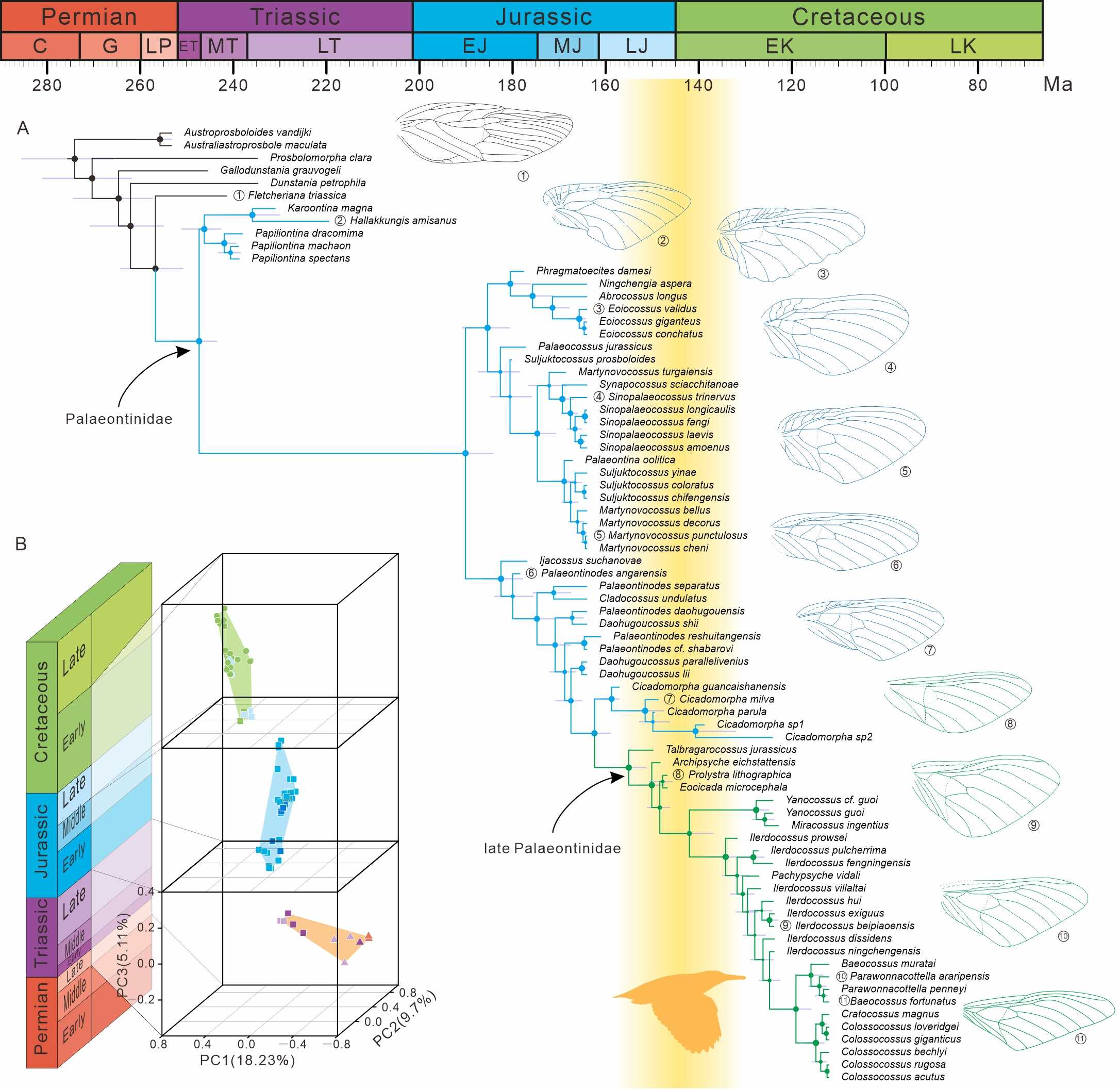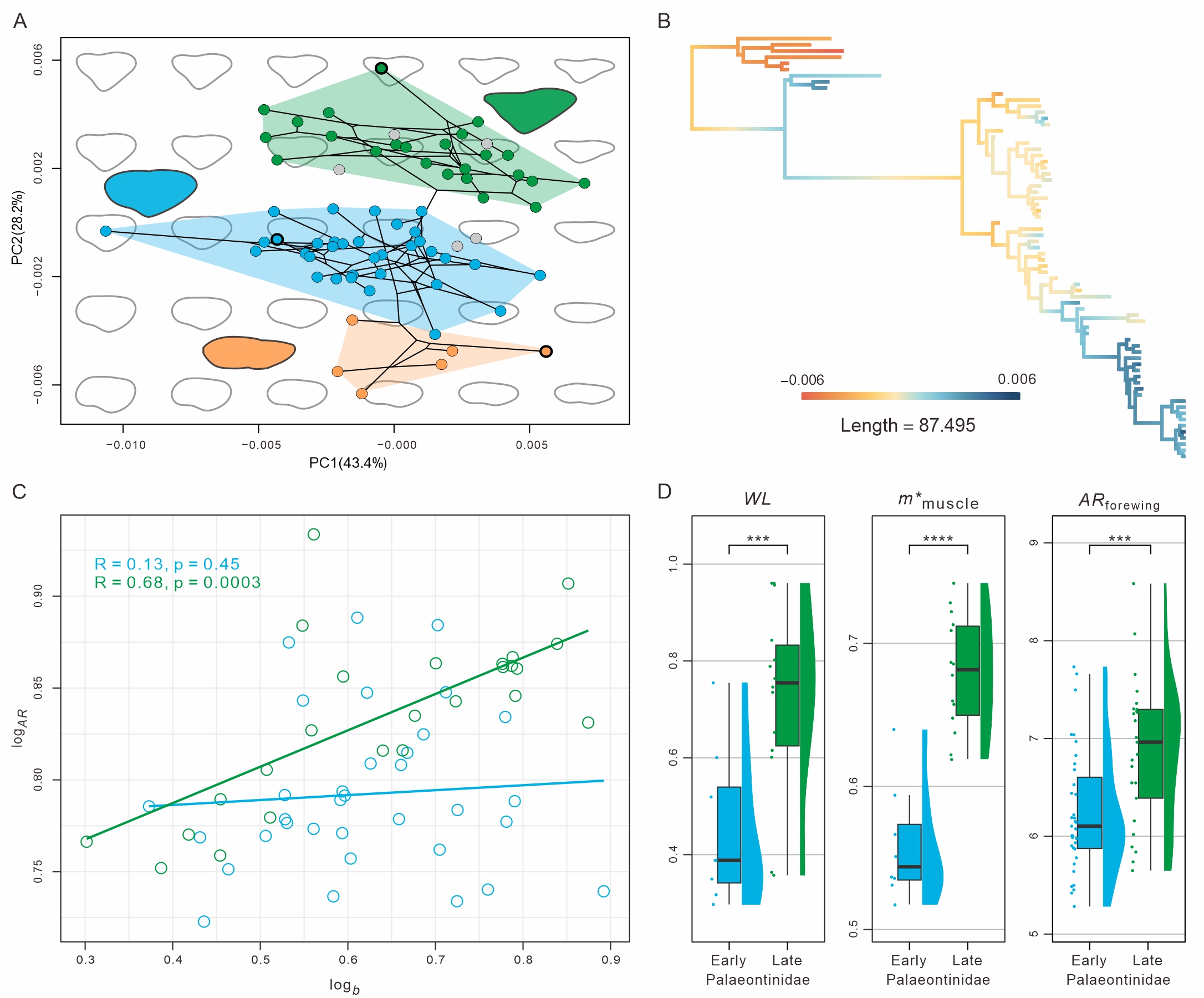
A recent study on global giant cicadas by Chinese scientists has provided novel insight on the adaptive aerodynamic evolution of Palaeontinidae, and supports the hypothesis of an aerial evolutionary arms race (Air Race) between Palaeontinidae and birds.
This research was published in Science Advances on October 26th, 2024.
Powered flight is one of the most important behavioral innovations in animal locomotion and provides fliers several ecological advantages. It has evolved independently in four faunal lineages: insects, pterosaurs, birds, and bats.
Insecta represents the earliest and most speciose flying group, displaying diverse wing morphologies and corresponding ecological flight behaviors and adaptations.
Palaeontinidae (Hemiptera: Cicadomorpha) is an extinct group of large arboreal insects ranging from the Middle Triassic to Late Cretaceous, with longest wingspan nearly 15 cm.
As close relatives of modern cicadas, giant cicadas exhibit similar morphologies and flight mechanisms. They represent an outstanding epitome of Mesozoic flying insects, exquisitely preserved with a vast array of morphological information on bodies and wings. This makes them an ideal model for investigating the relationship between wing morphology and flight behaviour in evolution.
Profs WANG Bo, ZHANG Haichun and their colleagues from Nanjing Institute of Geology and Palaeontology of the Chinese Academy of Sciences (NIGPAS) carried out a detailed and global investigation of all representatives of giant cicadas based on fossils from over a period of approximately 160 million years.
They compiled a database of detailed morphometric information on the bodies and wings of the giant cicadas. With this database, researchers reconstructed the evolutionary history of Palaeontinidae.
Phylogenetic analyses support the monophyly of Palaeontinidae, which originated near the beginning of the Middle Triassic. The results further recognize a distinct faunal turnover from early to late Palaeontinidae during the latest Jurassic–earliest Cretaceous.
After their appearance in the Late Jurassic, late Palaeontinidae diversified rapidly and dominated the palaeontinid fauna in the Early Cretaceous.
There is an abrupt morphological transition from early Palaeontinidae to late Palaeontinidae, during the latest Jurassic to earliest Cretaceous. Morphospace and morphological disparity analyses now revealed a distinctive morphospace partition occurring between early Palaeontinidae and late Palaeontinidae, and late Palaeontinidae occupied a smaller morphospace in terms of forewing gross morphology. There was also a distinct forewing shape transition from the oval condition in early Palaeontinidae to the triangularization of late Palaeontinidae.
The NIGPAS team also developed an aerodynamic modeling approach to estimate the flight performance of Palaeontinidae, based on their wing and body characteristics which was used to analyze the evolution of their flight ability.
Three indicative parameters of flight ability among insects were calculated based on morphometry: wing loading, relative flight power muscle mass, and wing aspect ratio. The combination of high wing loading, high relative flight muscle mass and high aspect ratio of wings in late Palaeontinidae suggest that they had evolved a significantly more advanced flight capability, including higher flight speed and greater maneuverability.
The faunal turnover from early to late Palaeontinidae coincided with the origination and diversification of early birds, supporting the hypothesis of an aerial evolutionary predator-prey arms race between birds (predators) and Palaeontinidae (prey).
Large flying insects such as Palaeontinidae, an almost untapped source of animal protein, may have been a stimulus for the evolution of early birds' arboreal and aerial habits, as well as their intricate flight systems. Conversely, early birds with progressive flight abilities could have exerted selective pressure on the evolution of Palaeontinidae.
The rise of birds in the late Mesozoic has probably influenced the evolution of two pre-existing fliers―pterosaurs and insects, arousing a remarkable evolutionary “Air Race” event during the latest Jurassic–earliest Cretaceous.
This proposed event is coeval with the well-known pterosaur faunal turnover from basal to pterodactyloid pterosaurs, accompanied by an increase of body size, migration to water-related habitats, as well as dietary habits shifting from insectivorous dominated to multifarious.
The competition between birds and pterosaurs is probably the main reason for pterosaur faunal turnover. The rise of birds inevitably imposed greater predation pressure on insects.
The “Air Race” event also overlapped with a turnover in the Odonata (dragonflies and damselflies) fauna from being dominated by Anisozygoptera to being dominated by Anisoptera and Zygoptera.
The “Air Race” event may well have influenced the evolution of pterosaurs and insects, thus reshaping the aerial ecosystem.
This research was supported by the National Natural Science Foundation of China, the Natural Scientific Foundation of Shandong Province, and Alexander von Humboldt-Stiftung.

Fig. 1. Representatives of early Palaeontinidae (A-D) and late Palaeontinidae (E-H). (Image by NIGPAS)

Fig. 2. The evolutionary history of Palaeontinidae. (Image by NIGPAS)

Fig. 3. Morphological disparity of forewings of Palaeontinidae and Dunstaniidae. (Image by NIGPAS)

Fig. 4. Geometric morphometric analysis of forewing shapes and flight performance traits of Palaeontinidae. (Image by NIGPAS)

Fig. 5. Ecological restoration of predator–prey interaction (chasing flights) between early birds (Longipteryx chaoyangensis) and late Palaeontinidae (Baeocossus fortunatus) in the Early Cretaceous. Artistic reconstruction by Dinghua Yang. (Image by NIGPAS)

86-10-68597521 (day)
86-10-68597289 (night)

52 Sanlihe Rd., Xicheng District,
Beijing, China (100864)

